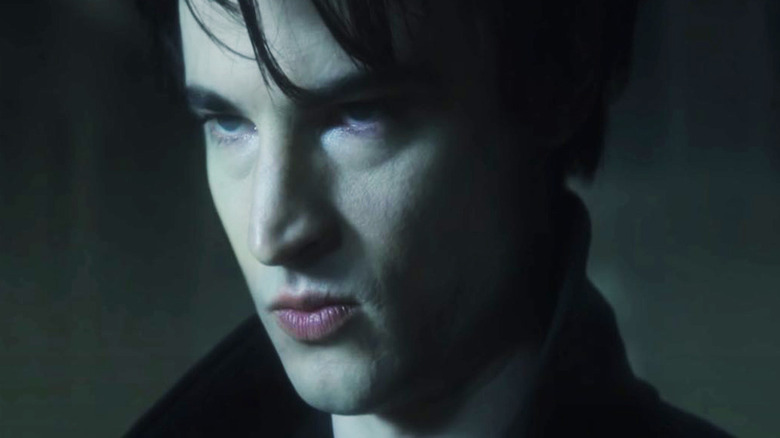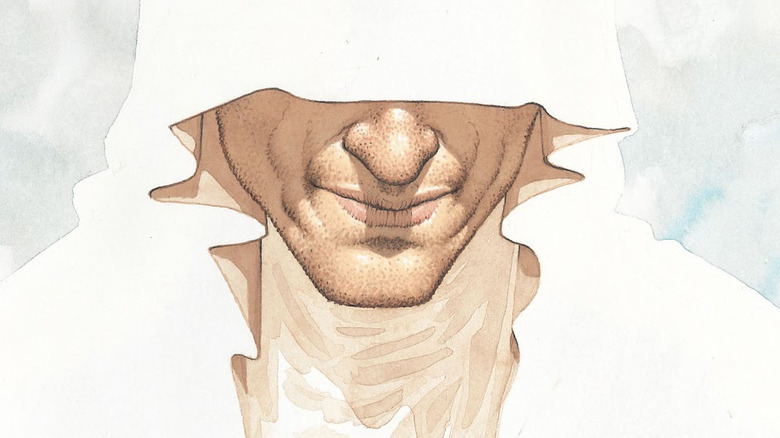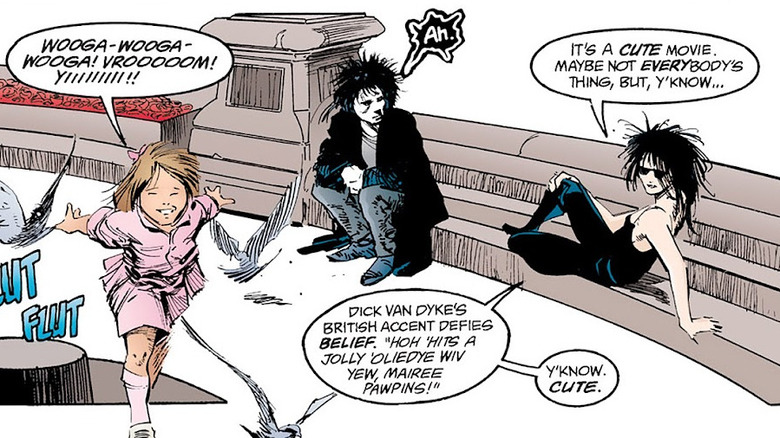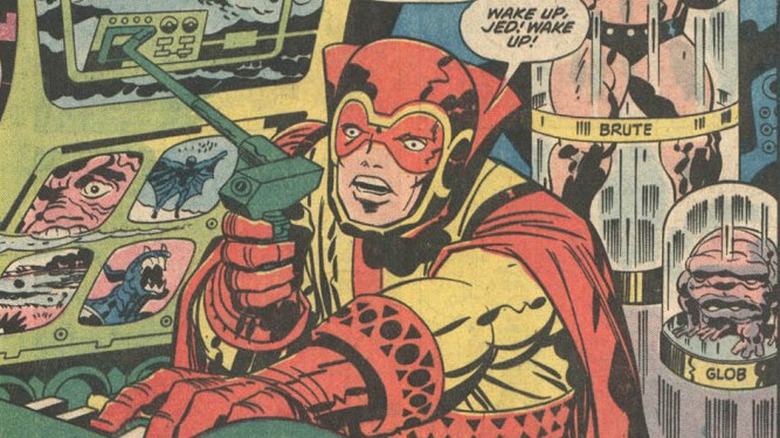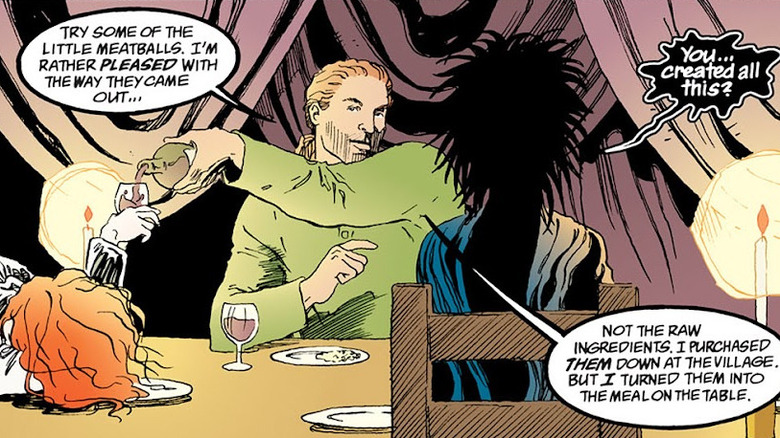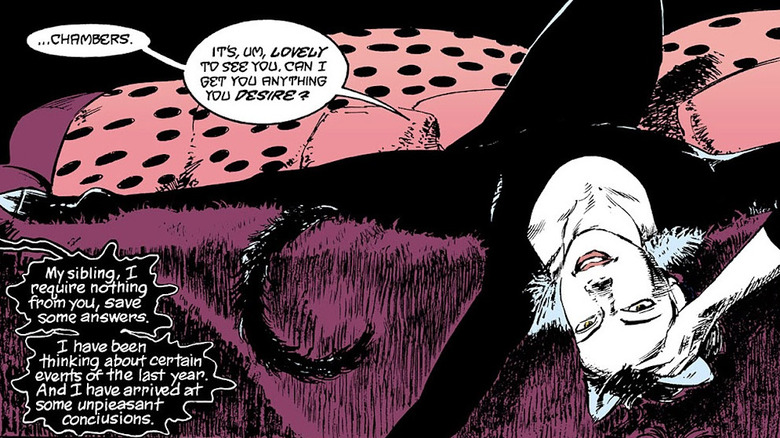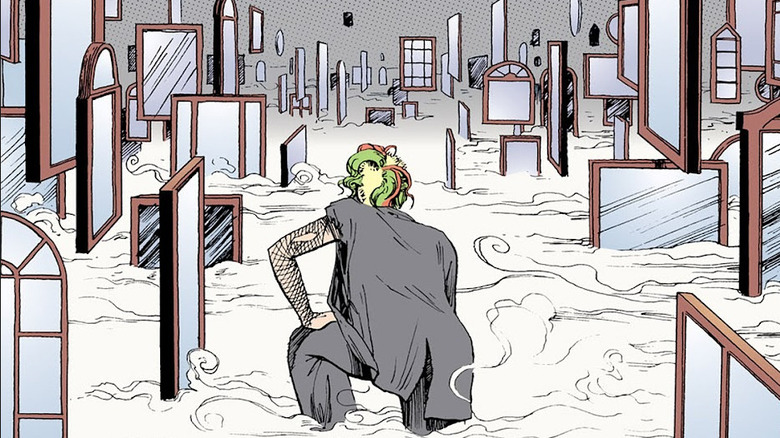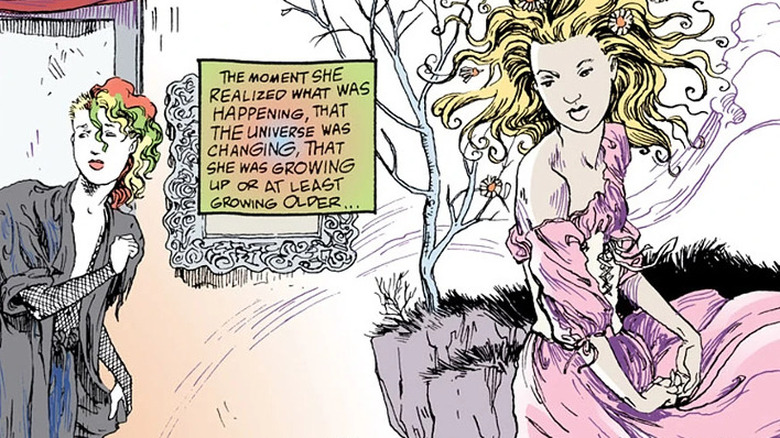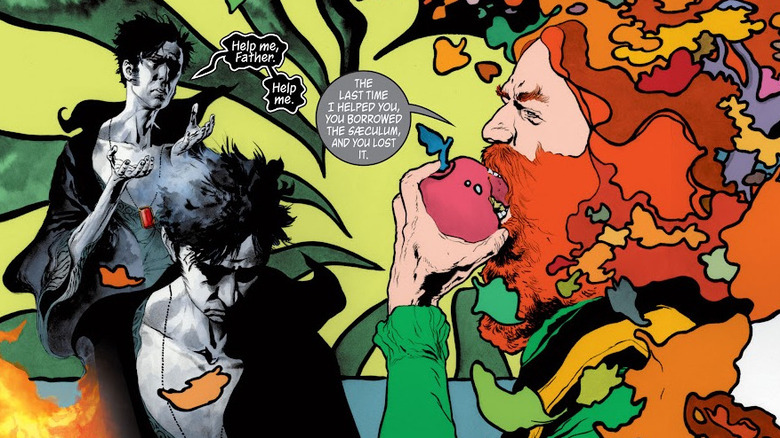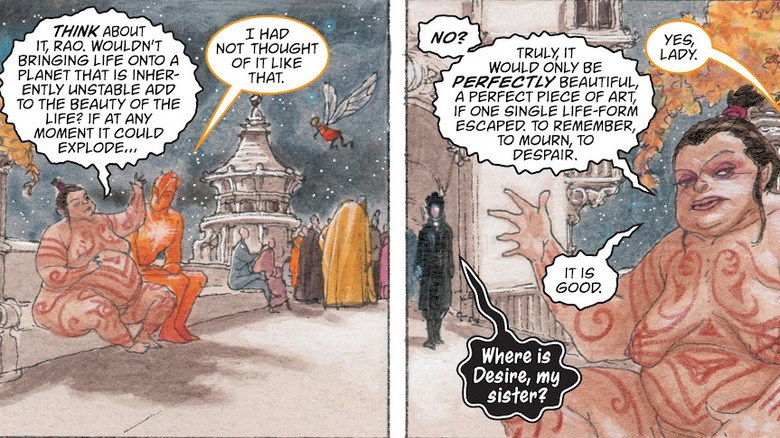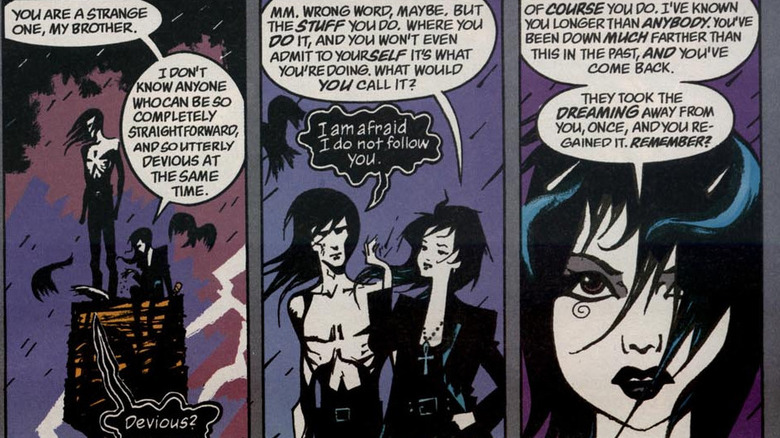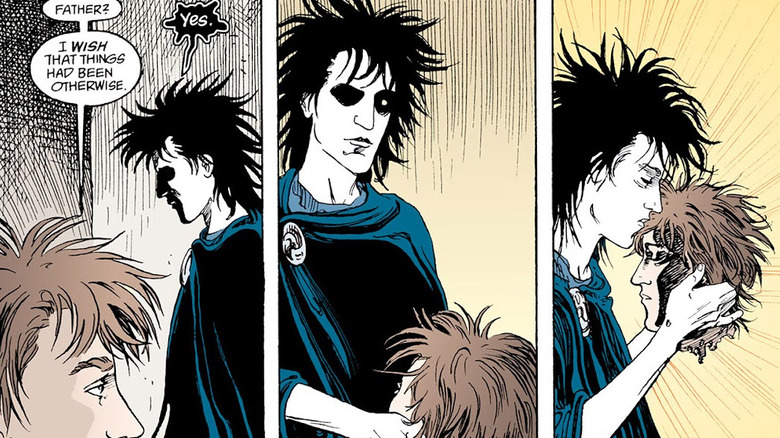The Untold Truth Of The Endless
"The Sandman" is, at heart, a family drama, centered around the Endless. Like all families, the Endless have their ups and downs. They snipe, reconcile, attack, and ignore each other, like all siblings do now and again. However, they are also godlike embodiments of certain universal constants. Destiny, Death, Dream, Destruction, Desire, Despair, and Delirium have offices to uphold and cosmic purposes in the order of all things to serve. But they just can't have a nice family dinner together without getting into an epically nasty argument.
While Dream is the protagonist of "The Sandman," he's not a hero. He is, in fact, as petty and vengeful as his most quarrelsome siblings, Desire and Despair. Destruction vacated his position centuries ago. Destiny stays aloof. Delirium is eternally off in her own little world. And Death — mature, easygoing Death — sighs over it all. This complex web of relationships sets all manner of events in motion, which the legendary series explores with unforgettable poignance and style. But how, readers might be wondering, did the Endless come to be? What rules govern their unfathomable powers? How have their bonds shifted, strengthened, and broken over the eons? With the advent of Netflix's "Sandman" TV series, there's never been a better time to answer these questions. This is the untold truth of the Endless.
Destiny's pre-Sandman origins
Destiny is the oldest member of the Endless. As soon as beings with fates of some kind appeared, Destiny was there to see them play out. This enigmatic figure is chained to his book, which contains a record of everything that has ever happened and all that will come to pass. As the endless eons march on, Destiny wanders his garden, leafing through this book. He's blind, but that doesn't matter — he sees the smallest details of existence with perfect clarity.
Destiny is the only member of the Endless not created for "The Sandman." His first appearance came in 1972's "Weird Mystery Tales" #1, where he serves as a horror host. All of the character's most familiar elements are present in this first appearance: He's a cloaked man with concealed eyes, chained to a book. Though he initially only introduces stories, he ultimately takes part in them as well. In 1981's "Secrets of Haunted House" #34, for example, he grants a model three wishes, though they don't pan out as she hopes. Being Destiny, he has this twist ending in mind from the beginning.
Destiny has continued to play a role in the wider DC universe. 2007's "The Brave and the Bold" series sees him realize that four people exist outside of his book's influence. These four people turn out to be the Challengers of the Unknown, who are able to avert catastrophe thanks to their unique omission.
Cheerful, compassionate Death
From her very first appearance in 1989's "The Sandman" #8, Death bucks all expectations. Instead of a terrifying skeleton wielding a scythe, she's an upbeat young woman with a taste for goth fashion. She scolds mopey Dream for not seeking her help when he was imprisoned, and for brooding when he should be happy to be free. Here, readers see how deeply she loves her brother, and how much she values fun.
Though Death is silly and friendly, she's also a professional who performs her eternal job with kindness and compassion. She's so empathetic, in fact, that she's the only member of the Endless who manages to get along with all her siblings — though she has no time for the kind of games Desire and Despair try to lure Dream into. However, every now and then, Death's curiosity leads her to make playfully interesting decisions, like when she makes Hob Gadling, a 14th century peasant, immortal.
Death occasionally appears in the DC universe. In 2010's "Action Comics" #894, she checks in on a nearly-dead Lex Luthor. Elsewhere, Captain Atom encounters her in Purgatory along with the Fourth World embodiment of death, the Black Racer. Though no one's exactly happy to see her, she's an undeniably friendly face at the end of the road.
The many Sandmen of Sandman
The Sandman is an old DC property, dating back to 1939. But the first Sandman isn't Dream — he's pulp hero Wesley Dodds. Dodds, who uses sleeping gas to knock criminals out, is one of the original members of the Justice Society of America. In 1974, he was succeeded by a new Sandman: Scientist Garrett Sanford, who lives partially in the Dream Dimension and partially in the real world. Aided by dream creatures Brute and Glob, he protects the Dream Dimension from those who would use it for evil. The extreme loneliness of the Dream Dimension exacts a heavy toll, however, and in 1988's "Infinity Inc." #50, readers learn Garrett Sanford has killed himself. Brute and Glob divert the spirit of the deceased Hector Hall (son of the Golden Age Hawkman and Hawkgirl) into Sanford's body, making him the new Sandman.
"The Sandman" made Dream of the Endless far and away the most popular Sandman, yet it manages to incorporate all these previous Sandmen into Dream's story. Dodds, we learn in the series' very first issue, is driven to become the Sandman when Dream is imprisoned. Hall and Sanford turn out to be helpless victims of escaped nightmares Brute and Glob, who are trying to take the Dreaming for themselves. Hall's son Daniel and his wife Lyta go on to become major players in "The Sandman" in utterly unexpected ways. Dream might be the Sandman, but he touches the lives of all Sandmen.
Destruction's attempts at creation
Readers are slowly introduced to every member of the Endless over the course of "The Sandman." Desire and Despair are key background characters in the "Doll's House" storyline, while Destiny and Delirium gain more spotlight during a family gathering towards the beginning of "Season of Mists." Here, a reference is made to a missing family member who left his office. Vague clues to his identity are dropped from time to time until he's fully introduced in a flashback in 1991's "Sandman Special" #1. This prodigal member of the Endless is Destruction.
Though he's often depicted wearing military regalia, Destruction isn't a war god — he's an agent of change. Sadly, change is indeed often brought about by war and the widespread death it causes. In the late 17th century, Destruction announced he had decided to quit his office. He saw the dawning of the Age of Reason, and understood it would lead to the devastation of the 20th century and the advent of nuclear warfare. Moreover, Destruction doesn't have to hold his office for destruction to occur — things fall apart all on their own. Why stick around to shepherd the misery of the modern age, then? His siblings find this objectionable, but he stays firm.
In the years since his departure, Destruction has attempted to act contrary to his nature, pursuing poetry, painting, and other acts of creation. He has no talent for any of it.
Desire's bet with Dream changes everything
Desire is perhaps the most dynamic member of the Endless. Twin to Despair, they are intensely powerful and capable of bending all manner of creatures towards all sorts of ends. Sibling tension ripples constantly through the Endless; there's an eternal sense that each member (except perhaps Death and Destiny) thinks their job is the most important, and underestimated by their siblings. Desire might believe this most firmly of all. They claim that sheer, unadulterated wanting is the most important force for living beings, capable of motivating them to do just about anything. Dream, in contrast, believes sentient creatures' need for dreams and the wider act of storytelling supersedes base desire.
Dream wins a bet to this effect (with the real-life Emperor Norton I of San Francisco as their test subject) in "The Sandman" #31. This kicks off Desire's blood feud with him. They vow to force Dream into killing a family member, which will incur the vicious Furies' wrath. As fans know, this is exactly what happens. Few members of the Endless meddle in their siblings' affairs to this extent, but Desire isn't just any old member of the Endless. When they want something — revenge, in this case — nothing can stop them from trying to get it. This is, of course, their nature ... and their brother's downfall.
Despair's eternal vigil
We all want things, whether they're comfortable homes to call our own, romantic love, or personal fulfillment. When we can't have them, despair sets in. This is why moribund, terrifying Despair is Desire's twin. Despair is nearly always in cahoots with Desire: Together, they play wicked games meant to provoke and upset. But Despair isn't entirely without feelings. She openly laments Destruction's absence, and recalls that he could defuse family arguments with melancholy fondness. Moreover, when Dream dies, she speaks with genuine love at his funeral.
Despair's most memorable aspect, however, is her home. Every member of the Endless has their own realm, which reflects their nature. Dream has the Dreaming, which contains his dazzling castle. Desire lives in a huge, triumphant, flesh-and-blood statue of themselves called the Threshold. Destiny has his infinite garden. Depair's realm is one of the most visually arresting: It's an endless void filled with scores of windows. In the real world, every one of these windows is a mirror, which the despondent look into in the depths of their hopelessness. Gray-skinned Despair watches all of them, as patient as she is morose. This powerful metaphor for misery lingers long after the final page is turned.
When Delight became Delirium
Delirium doesn't embody simple insanity — she represents what it is to be totally unmoored from reality. But she isn't a being of complete chaos. In her more lucid moments, Delirium reveals she knows things that aren't in Destiny's book, though she keeps these truths to herself. Perhaps the biggest is how and why she became Delirium at all. You see, once upon a time, Delirium was Delight. This transformation remains one of the biggest mysteries of "The Sandman."
Destruction hints that Delight became Delirium because of some kind of trauma, possibly a broken heart. Even when she was Delight, she was still the most skittish and sensitive member of the Endless — something terrible absolutely could have changed her that deeply. Moreover, this hypothesis is in keeping with a key fact about the Endless: Each of them personifies both an ideal and its opposite. Dream is a reflection of reality, Despair of hope, Destiny of free will, Desire of fulfillment, Destruction of creation, Death of life, and Delirium of sanity. It stands to reason that Delight reflected pain, horror, and trauma. When overwhelmed by that pain, she might have become Delirium, who offers glimmers of order in her madness.
The Endless' parents
In 2013's "The Sandman: Overture," Dream is faced with the consequences of a decision he made long ago. When he was young and inexperienced, he spared a dream vortex, who inherently broke down the barriers between people's dreams. He was eventually forced to destroy her world, but his lethal delay leads to a star's madness, which threatens to spread and eventually cause the end of all things. Thus, Dream concocts a plan to fix his mistake. It involves visiting his parents.
The Endless don't refer to each other as siblings out of ceremony — they actually are the children of two primordial forces. Their father is Time, the force that sets everything into motion. When Dream visits Time, his father is skeptical: Every time his children come to him, they want something. The only child Time isn't angry with is Destiny, who never bothers him. It was Time who gave the eldest of the Endless his Book of Souls.
Later, Dream visits his mother, Night. Night is the primordial void who existed before all things. Night offers to let Dream stay in her realm forever, shielding him from the end of the universe. But he refuses this offer, much to his mother's chagrin. Thus, Dream's scheme to get his parents back together in order to fix the universe fails — but at least "Sandman" fans finally got to meet the beings who spawned the fractious brood that is the Endless.
The death of Despair and the birth of Superman
Many thousands of years ago, someone murdered the first Despair. The identity of her killer and their motive remain a mystery, though Daniel, the second Dream, tells Lyta Hall that the culprit will suffer until the end of time. But who, readers wonder, was this first Despair?
We get a lengthy look at this enigmatic predecessor in 2003's "The Sandman: Endless Nights." The first Despair looks mostly identical to the second Despair, and is also constantly naked, but her body is covered in elaborate red tattoos. She also seems far more confident and well-spoken, especially in conversation with Rao, the sun around which Krypton orbits. She suggests that bringing life to such an inherently unstable planet, capable of crumbling at any moment, would be exquisitely poignant — especially if a single, solitary survivor endures beyond the planet's death. This is, of course, what happens millennia later, when Kal-El, better known as Superman, comes to Earth. (Pay no attention to the fact that plenty of DC characters actually survived the destruction of Krypton.) That's right: Without the first Despair of the Endless, there would be no Man of Steel.
The death of Dream
Neil Gaiman was once asked to describe the story of "The Sandman" in 25 words or less. He responded, "The Lord of Dreams learns that one must change or die, and makes his decision." Though this leaves a lot out, it's pretty accurate. The experience of being imprisoned in the first arc forces Dream to slowly become more human over the course of the series. Eventually, Dream comes to understand that changing in this way prevents him from properly executing his office. In other words, he can't change, and respects his position and power too deeply to walk away, as Destruction has. Thus, he chooses death.
This plan is far more deeply rooted in the story than even the most diehard "Sandman" fans might realize. Early on, Dream lays claim to Daniel Hall, a mortal child born in his realm who will become his replacement. Puck and Loki eventually kidnap Daniel, as Dream might have suspected, given their cruel natures. Dream later agrees to help Delirium find Destruction, knowing he will have to kill his son Orpheus to do so. Spilling family blood incurs the wrath of the Furies, which results in Dream's death. Dream might be acting subconsciously, with intent, or something in between as he puts these events in motion. Death considers all these options before she takes her brother into the afterlife. But what is clear is that he cannot continue on, and that Daniel's humanity makes him an ideal successor.
The rest of the family
Getting involved with mortals, especially romantically, rarely ends well for Dream ... but that doesn't stop him from doing it. Dream's romance with the muse Calliope even produced a child, Orpheus. A legendary musician, he's torn apart by frenzied maenads. Only his head is left behind, which is capable of speech and even song. Orpheus begs his father to kill him, but Dream refuses to do so until much, much later. When Dream finally does dispatch his son, the act brings the vengeance of the Furies upon him.
Orpheus isn't the only child of the Endless, however. When Dream is trapped by Roderick Burgess, a number of people succumb to a mysterious sleeping sickness. Desire impregnates one such dreamer, a young woman named Unity Kinkaid. Unity bears a child named Miranda, who has children named Rose and Jed. Rose inherits her grandmother's status as a dream vortex, making her a rare mortal being capable of merging the dreams of vast numbers of people. This can cause untold destruction. Desire concocts a convoluted plan to bring Dream to his knees through this unique state of affairs: Forced to destroy the vortex, Dream will be forced to spill family blood. However, Unity steps in to sacrifice herself, foiling Desire's plot.
